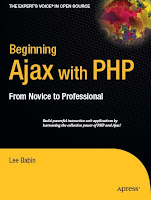PHP & MySQL For Dummies 3rd edition
Release: 2007
Filetype/ext: PDF
Size : 2,832 KB
From : wiley
419 pages
VI Part, 17 chapters
DETAIL THIS BOOKS
DOWNLOAD THIS BOOKS
Posted by admin at 9:34 PM 0 comments
Chapter 1: Advanced PHP Techniques
Multidimensional Arrays
Advanced Function Definitions
The Heredoc Syntax
Using printf() and sprintf()
Chapter 2: Developing Web Applications
Documenting Code
Code Style and Structure
Modularizing a Web Site
Affecting the Browser Cache
Chapter 3: Advanced Database Concepts
Storing Sessions in a Database
Working with U.S. Zip Codes
Creating Stored Functions
Displaying Results Horizontally
Chapter 4: Security Techniques
Remembering the Basics
Validating Form Data
Using PECL Filter
Authentication with PEAR Auth
Using MCrypt
Chapter 5: E-commerce Techniques
E-commerce Concepts
Creating the Database
Creating the Configuration File
Making the Template
Creating the Index Page
Browsing by Category
Showing a Product
Implementing a Shopping Cart
Validating Credit Cards
Chapter 6: Basic Object-Oriented Programming
OOP Theory
Defining a Class
Creating an Object
The $this Attribute
Creating Constructors
Creating Destructors
Autoloading Classes
Chapter 7: Advanced OOP
Advanced Theories
Inheriting Classes
Inheriting Constructors and Destructors
Overriding Methods
Access Control
Using the Scope Resolution Operator
Creating Static Members
Abstract Classes and Methods
Chapter 8: Real-World OOP
Catching Exceptions
Extending the Exception Class
Using the Cart Class
Chapter 9: Networking with PHP
Accessing Other Web Sites
Working with Sockets
Performing IP Geolocation
Using cURL
Chapter 10: PHP and the Server
Compressing Files
PHP-GTK
Establishing a cron
Scheduling Tasks on Windows
Using COM with PHP
Chapter 11: PHP’s Command-Line Interface
Testing Your Installation
Executing Bits of Code
Creating a Command-Line Script
Running a Command-Line Script
Working with Command-Line Arguments
Taking Input
Chapter 12: Using PEAR
Using Benchmark
Using HTML_QuickForm
Using Mail_Mime
Chapter 13: Ajax
Introduction to Ajax
A Simple Example
Full-Fledged Ajax
Debugging Ajax Applications
Chapter 14: XML and PHP
What Is XML?
XML Syntax
Attributes, Empty Elements, and Entities
Document Type Definitions
Parsing XML
Creating an RSS Feed
DOWNLOAD THIS BOOKS
Labels: PHP, Programming
Posted by admin at 10:30 AM 0 comments

Posted by admin at 10:08 AM 0 comments
Free ebooks and tutorial downloads, Programming, Java, Pdf ebooks, Acrobat files, download free java pdf tutorial, java programming tutorial, C++, C#, JSP, J2ME, J2EE, XML, API, Security, Hacking, PHP tutorial, Microsoft Office, Excel, Access, Oracle, Ruby on Rails, Java Script, Java Servlets, Macintosh, MacOsX, Windows, Microsoft Access, Photoshop Tutorial